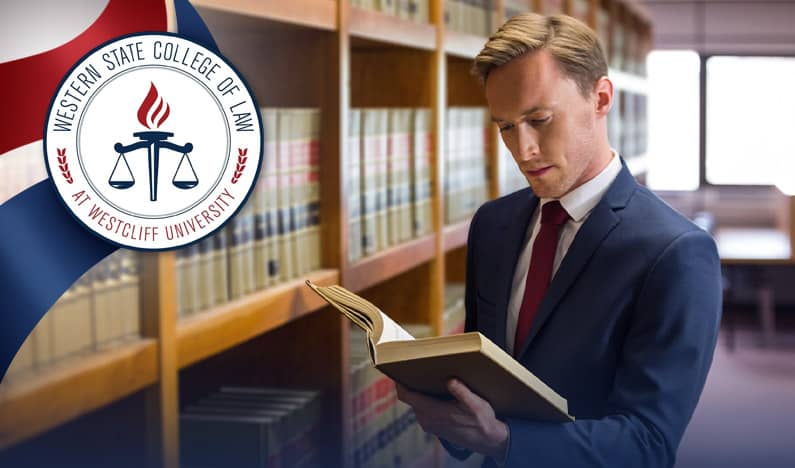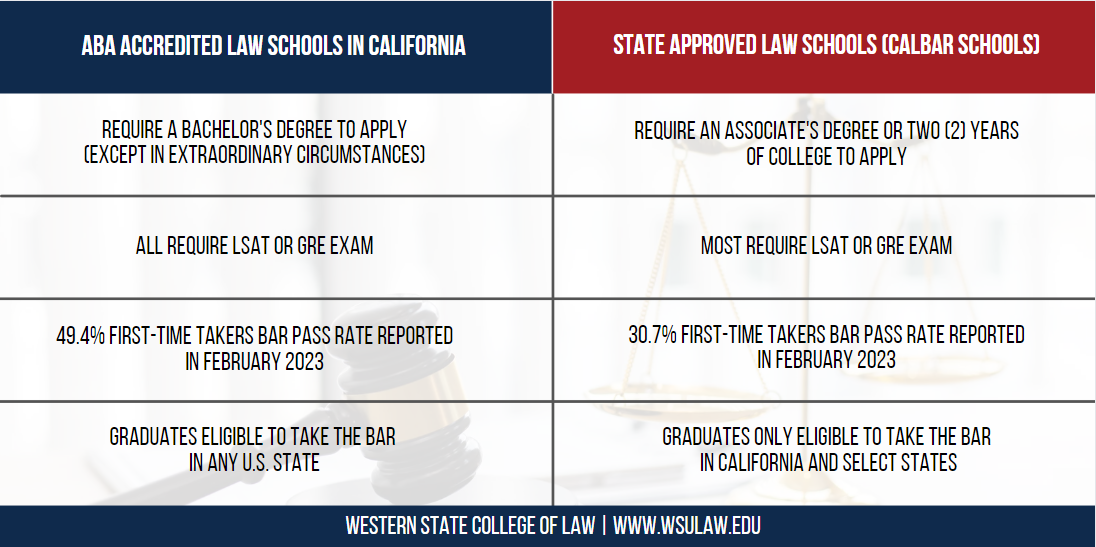There are many ABA accredited law schools in California and many state accredited law schools in California. Differentiating between the two types of accredited programs and choosing the right one may seem difficult. Although both types of accredited law schools offer a more rigorous curriculum than unaccredited law schools, ABA accreditation and state accreditation are not the same, and there are many differences that are unknown to the general public. Below are a few key things to keep in mind when considering an accredited law school program in California.
Admission Requirements
Although the steps to apply to a law school in California are similar among schools, the admission requirements for state accredited law schools set by California’s Committee of Bar Examiners are more lax than the standards set for ABA approved law schools. State accredited law schools only require two years of college work, which means either an associate’s degree or half of an unfinished bachelor’s degree. ABA law schools require a bachelor’s degree, except in extraordinary circumstances. In addition, some California accredited law schools do not require a standardized entrance exam, such as the LSAT or GRE. However, most California accredited law schools do require an exam, and all ABA approved law schools require one.
Bar Passage Rates
In order to obtain a law license in North America, a law school graduate must be admitted by each state or province that the graduate is interested in. Typically, this involves becoming eligible to take a bar exam, and each state and province has its own requirements.

Part of the reason for the discrepancy is that the ABA’s standards are much stricter, in terms of professors’ credentials, curricula, facilities, staffing and outcomes such as bar pass rates. In fact, the ABA requires law schools to have a 75% pass rate for graduates within two years of graduation. In contrast, California only requires state accredited law schools to have a 40% pass rate within five years.
If becoming a licensed attorney is important, pursuing an ABA approved education can save time, and ultimately money and stress, by helping graduates pass the bar earlier and more often. Sometimes, the lower tuition at a state accredited law school is offset by the lost income and opportunities a graduate would have had from an ABA approved law school.
Opportunities to Practice Law Outside of California
Those who graduate from an ABA approved law school are eligible to take the bar exam in any U.S. state. In addition, graduates from ABA approved law schools are eligible to pursue a law license in Canada. This means that graduates from an ABA program have the freedom to choose where they want to become a lawyer in North America.
A graduate from a California state accredited law school, also known as a Calbar school, is only eligible to take the California bar exam. This means that Calbar school graduates can only become California attorneys upon graduation. Although graduates from Calbar schools may be eligible to apply for a license in another jurisdiction after practicing for many years, not all states offer reciprocal licensure and those that do require many years of waiting.
Quality and Type of Professors
At Calbar schools, typically almost all of the professors are part-time adjunct professors. While Calbar schools sell this as a benefit, stating that the majority of their faculty is comprised of real-world practitioners, students are deprived of the benefits of learning from professors who are dedicated full-time to teaching.
At ABA approved law schools, full-time faculty must teach a majority of the law school’s credits in addition to teaching almost the entire first year of a student’s coursework. In addition, the ABA sets high standards for professors, measuring their competence in terms of academic qualifications, teaching effectiveness and scholarship.
While Calbar law schools can save money by hiring part-time adjuncts, hiring full-time faculty ensures that students learn from professors who are dedicated to teaching the law so that students learn the foundational knowledge and skills for a successful performance on the bar exam and in practice. Adjunct faculty offer benefits, particularly if attorneys and judges can impart practical knowledge in the classroom, but only if students first learn under full-time faculty and understand essential foundational principles. All ABA law schools, including Western State College of Law, offer electives taught by adjunct professors after the first year of law school.
Employment Outcomes
When evaluating law schools, post-graduate employment results are extremely important. Most law school students attend law school for the specific purpose of becoming an attorney or advancing their current career. Therefore, ABA approved law schools are required to provide career counselors who assist students with obtaining jobs. In addition, ABA approved law schools are required to report their employment outcomes ten months after graduation for the ABA to review.

In addition, although many Calbar law school graduates obtain career success, some California employers state in their job requirements that candidates must be a graduate of an ABA approved law school. For the largest number of employment opportunities, transparency in employment outcomes and guaranteed career support, an ABA approved law school offers the superior choice.
Tuition Cost
Because it is far cheaper to run a Calbar accredited school, the tuition at a typical Calbar school is approximately half of the tuition of an ABA approved law school in California. However, the true cost could be measured in terms of how many times a Calbar graduate will need to take the bar exam in order to pass, how long it will take to find gainful employment and the limited opportunities for practicing law outside of California.
In addition, there are opportunities at ABA approved law schools to obtain scholarships that could cover nearly all of the tuition. State accredited law schools typically offer only a few thousand dollars in scholarships, covering approximately 10% of tuition on average.
The many advantages of attending an ABA approved law school are numerous. Most students choose a Calbar school believing that it is more convenient and cheaper. However, ABA law schools can offer a superior education, sometimes with part-time law programs in California, at an affordable cost for legal education.
If you are interested in learning about California’s most affordable ABA accredited law school, please visit Western State College of Law’s portal for prospective students.


